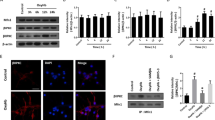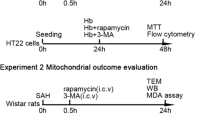Abstract
p38 mitogen-activated protein kinase (MAPK) is a major player in mitochondrial dysfunction after subarachnoid hemorrhage (SAH). Moreover, DJ-1, which responds to oxidative stress and translocates to mitochondria, maintains mitochondrial homeostasis. Although a few studies have demonstrated that DJ-1 indirectly regulates p38 activation, the relationship between DJ-1 and p38 in mitochondrial dysfunction after SAH has not been delineated. Using an in vitro SAH model, alterations in p38, p-p38, DJ-1, and autophagic-related protein expression were detected. As expected, p38 inhibitor significantly blocked excessive expression of p38 and p-p38 after SAH, whereas total DJ-1 expression and mitochondrial DJ-1 were up-regulated. Further analysis showed that p38 inhibitor significantly blocked oxyhemoglobin (OxyHb) induced mitochondrial dysfunction, including mitochondrial membrane potential depolarization and reactive oxygen species (ROS) release. In addition, p38 inhibitor restored OxyHb-induced abnormal autophagic flux at the initiation and formation stage by regulating Atg5, beclin-1, the ratio of LC3-II/LC3-I, and p62 expression. This study suggested that overexpression of p38 induced the accumulation of mitochondrial dysfunction partly due to abnormal activation of autophagy, which largely relied on DJ-1 mitochondrial translocation.





Similar content being viewed by others
References
Ansar S, Edvinsson L (2008) Subtype activation and interaction of protein kinase C and mitogen-activated protein kinase controlling receptor expression in cerebral arteries and microvessels after subarachnoid hemorrhage. Stroke 39(1):185–190
Armstrong JS (2007) Mitochondrial medicine: pharmacological targeting of mitochondria in disease. Br J Pharmacol 151(8):1154–1165
Ayer RE, Zhang JH (2008) Oxidative stress in subarachnoid hemorrhage: significance in acute brain injury and vasospasm. Acta Neutochir Suppl 104:33–41
Blachinton J (2009) Formation of a stabilized cysteine sulfinic acid is critical for the mitochondrial function of the parkinsonism protein DJ-1. J Biol Chem 284:6376–6485
Bitar MS, Liu C, Ziaei A, Chen Y, Schmedt T, Jurkunas UV (2012) Decline in DJ-1 and decreased nuclear translocation of Nrf2 in Fuchs endothelial corneal dystrophy. Invest Ophthalmol Vis Sci 53(9):5806–5813
Cahill WJ, Calvert JH, Zhang JH (2006) Mechanisms of early brain injury after subarachnoid hemorrhage. J Cereb Blood Flow Metabol 26(11):1341–1353
Canet-Aviles RM et al (2004) The parkinson’s disease protein DJ-1 is neuroprotective due to cysteine-sulfinic acid-driven mitochondrial localization. Proc Natl Acad Sci U S A 101:9103–9108
Chen S, Wu H, Tang J, Zhang J, Zhang JH (2015b) Neurovascular events after subarachnoid hemorrhage: focusing on subcellular organelles. Acta Neurochir Suppl 120:39–46
Chen Y et al (2017) AMPK attenuates ventricular remodeling and dysfunction following aortic banding in mice via the Sirt3/oxidative stress pathway. Eur J Pharmacol 814:335–342
Chen Y, Huang LY, Zhang HY, Sun HY, Zhou WK (2016) EGCG protective mitochondrial dysfunction after subarachnoid haemotthage via inhibition p38α pathway. J Funct Foods 23:115–123
Chen Y, Sun HY, Huang LY, Li JX, Zhou WK, Chang JL (2015a) Neuroprotective effect of radix trichosanthis saponins on subarachnoid hemorrhage. Evid Based Complement Alternat Med 2015:313657
Gao H, Yang W, Qi Z, Lu L, Duan C, Zhao C, Yang H (2012) DJ-1 protects dopaminergic neurons against rotenone-induced apoptosis by enhancing ERK-dependent mitophagy. J Mol Biol 423(2):232–248
González-Polo R et al (2009) Silencing DJ-1 reveals its contribution in paraquat-induced autophagy. J Neurochem 109:889–898
Guo Z et al (2016) Lipoxin A4 reduces inflammation through formyl peptide receptor 2/p38 MAPK signaling pathway in subarachnoid hemorrhage rats. Stroke 47(2):490–497
Guo Y, Li Z, Shi C, Li J, Yao M, Chen X (2017) Trichostatin A attenuates oxidative stress-mediated myocardial injury through the FoxO3a signaling pathway. Int J Mol Med 40(4):999–1008
Hadjal Y, Hadadeh O, Yazidi CE, Barruet E, Binétruy B (2013) A p38mapk-p53 cascade regulates mesodermal differentiation and neurogenesis of embryonic stem cells. Cell Death Dis 4(7):e737
Huang L et al (2013) Inhibitory effects of p38 inhibitor against mitochondrial dysfunction in the early brain injury after subarachnoid hemorrhage in mice. Brain Res 1517:133–140
Höcker R, Walker A, Schmitz I (2013) Inhibition of autophagy through MAPK14mediated phosphorylation of ATG5. Autophagy 9(3):426–428
Hod Y, Pentyala SN, Whyard TC, EI-Maghrabi MR (1999) Identification and characterization of a novel protein that regulates RNA-protein interaction. J Cell Biochem 72:435–444
Hop JW, Rinkel GJ, Algra A, van Gijn J (1997) Case-fatality rates and functional outcome after subarachnoid hemorrhage: a systematic review. Stroke 28:660–664
Ito K et al (2006) Reactive oxygen species act through p38 MAPK to limit the lifespan of hematopoietic stem cells. Nat Med 12(4):446–451
Kaneko Y (2014) DJ-1 ameliorates ischemic cell death in vitro possibly via mitochondrial pathway. Neurobiol Dis 62:56–61
Kato I et al (2013) Oxidized dj-1 inhibits p53 by sequestering p53 from promoters in a DNA-binding affinity-dependent manner. Mol Cell Biol 33(2):340–359
Kim BJ, Ryu SW, Song BJ (2006) JNK- and p38 kinase-mediated phosphorylation of bax leads to its activation and mitochondrial translocation and to apoptosis of human hepatoma HepG2 cells. J Biol Chem 281(30):21256–21265
Kulisz A, Chen N, Chandel NS, Shao Z, Schumacker PT (2002) Mitochondrial ROS initiate phosphorylation of p38 MAP kinase during hypoxia in cardiomyocytes. Am J Physiol Lung Cell Mol Physiol 282(6):L1324–L1329
Mo JS et al (2010) DJ-1 modulates the p38 mitogen-activated protein kinase pathway through physical interaction with apoptosis signal-regulating kinase 1. J Cell Biochem 110(1):229–237
Nagao M et al (2017) High-density lipoprotein protects cardiomyocytes from oxidative stress via the PI3K/mTOR signaling pathway. FEBS Open Bio 7(9):1402–1409
Saeed U et al (2009) Redox activated MAP kinase death signaling cascade initiated by ASK1 is not activated in female mice following MPTP: novel mechanism of neuroprotection. Neurotox Res 16(2):116–126
Sasaki T et al (2004) Role of p38 mitogen-activated protein kinase on cerebral vasospasm after subarachnoid hemorrhage. Stroke 35(6):1466–1470
Sehba FA, Pluta RM, Zhang JH (2011) Metamorphosis of subarachnoid hemorrhage research: from delayed vasospasm to early brain injury. Mol Neurobiol 43:27–40
Shin B, Cowan DB, Emani SM, Del Nido P, McCully JD (2017) Mitochondrial transplantation in myocardial ischemia and reperfusion injury. Adv Exp Med Biol 982:595–619
Smaili SS, Hsu YT, Sanders KM, Russelll JT, Youle RJ (2001) Bax translocation to mitochondria subsequent to a rapid loss of mitochondrial membrane potential. Cell Death Differ 8(9):909–920
Smith JA, Weidemann MJ (1993) Further characterization of the neutrophil oxidative burst by flow cytometry. J Immunol Methods 62:261–268
Sugawara T, Jadhav V, Ayer R, Chen W, Suzuki H, Zhang JH (2009) Thrombin inhibition by argatroban ameliorates early brain injury and improves neurological outcomes after experimental subarachnoid hemorrhage in rats. Stroke 40(4):1530–1532
Taira T, Saito Y, Niki T, Iguchi-Ariga SM, Takahashi K, Ariga H (2004) DJ-1 has a role in antioxidative stress to prevent cell death. EMBO Rep 5:213–218
Tomar A et al (2017) Galangin ameliorates cisplatin induced nephrotoxicity in vivo by modulation of oxidative stress, apoptosis and inflammation through interplay of MAPK signaling cascade. Phytomedicine 34:154–161
Won KJ et al (2013) DJ-1/park7 protects against neointimal formation via the inhibition of vascular smooth muscle cell growth. Cardiovasc Res 97(3):553–561
Zhang Q et al (2012) DJ-1 promotes the proteosomal degradation of Fis1: implications of DJ-1 in neuronal protection. Biochem J 447(2):261–269
Zhang X, Zhao XD, Shi JX, Yin HX (2011) Inhibition of the p38 mitogen-activated protein kinase (MAPK) pathway attenuates cerebral vasospasm following experimental subarachnoid hemorrhage in rabbits. Ann Clin Lab Sci 41(3):244–250
Zhang XM et al (2015) Suppression of mitochondrial fission in experimental cerebral ischemia: the potential neuroprotective target of p38 MAPK inhibition. Neurochem Int 90:1–8
Zhuang S, Demirs JT, Kochevar IE (2000) p38 mitogen-activated protein kinase mediates bid cleavage, mitochondrial dysfunction, and caspase-3 activation during apoptosis induced by singlet oxygen but not by hydrogen peroxide. J Biol Chem 275(34):25939–25948
Acknowledgements
This work was supported by the National Natural Science Foundation of China (No. 81541030) and Henan Province of Natural Science Foundation (No. 182300410299).
Author information
Authors and Affiliations
Corresponding author
Ethics declarations
Conflict of Interest
The authors declare no conflicts of interest.
Rights and permissions
About this article
Cite this article
Huang, L., Hou, Y., Wang, L. et al. p38 Inhibitor Protects Mitochondrial Dysfunction by Induction of DJ-1 Mitochondrial Translocation After Subarachnoid Hemorrhage. J Mol Neurosci 66, 163–171 (2018). https://doi.org/10.1007/s12031-018-1131-1
Received:
Accepted:
Published:
Issue Date:
DOI: https://doi.org/10.1007/s12031-018-1131-1




